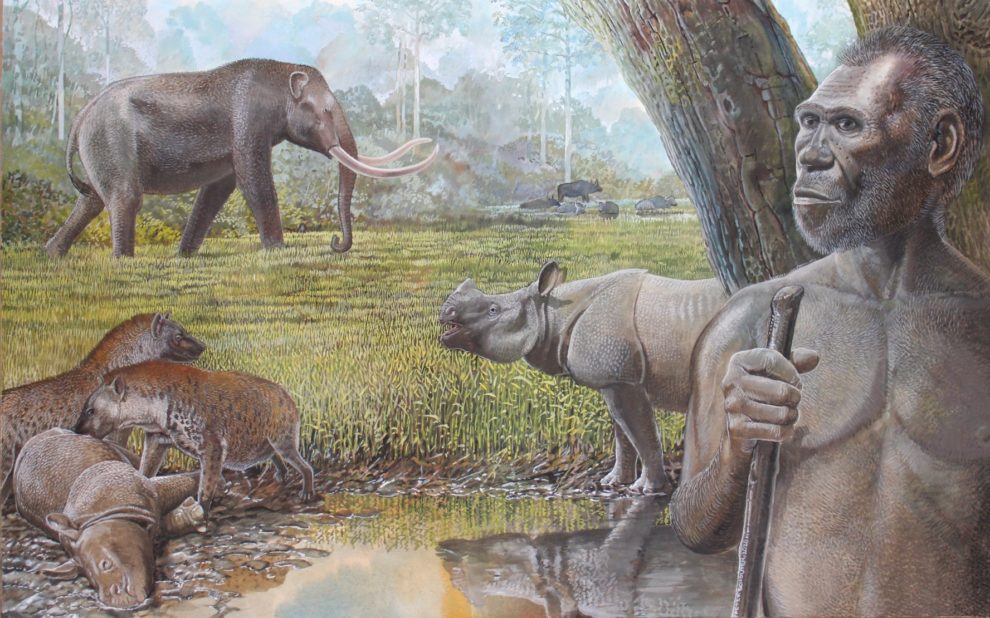
Today, lush tropical vegetation characterizes Southeast Asia, but in a phase of the Pleistocene, extensive savannas extended there, according to a study. The corresponding transformation from rainforests to savannahs and back again has had a major impact on the fate of animals and human forms in the region, say the scientists. Above all, the disappearance of the grasslands about 100,000 years ago led to the extinction of large animals and probably also of early representatives of the hominini. Perhaps only Homo sapiens got along well with life in the jungle.
We live in the Holocene today, but the roots of our species are in the Pleistocene. This is the period in the history of the earth that began about 2.6 million years ago and ended about 12,000 years ago. This era was characterized by a change between cold and warm periods. In the frosty phases, large parts of the north were covered by thick ice or cold steppe landscapes in which mammoths and co grazed. But also in other regions the earth showed different characteristics than today: The sea level was significantly lower and so our planet had huge areas of land that are now under water. There are already numerous indications that in the course of the Pleistocene and its transition to the present there were also intensive changes in the conditions in many regions, which strongly influenced the fate of the flora and fauna and the representatives of the homo genus.
The development of Southeast Asia in sight
In this context, Julien Louys from Griffith University in Brisbane and Patrick Roberts from the Max Planck Institute for the History of Man are now focusing on developments in a region that has so far been relatively little explored. It is known that in the Pleistocene, today’s islands of Southeast Asia were part of a vast area of land that stretched from mainland Indochinese to far south. Findings show that probably five representatives of Hominini lived there in the middle Pleistocene, including Homo erectus. Southeast Asia is therefore an important region for understanding the migration and extinction of hominini and mammal species, the researchers say.
In order to gain clues about the development of living conditions in this region over the last 2.6 million years, Louys and Roberts carried out isotope analyzes on numerous fossil mammalian teeth from various localities in Southeast Asia. As they explain, based on the proportions of certain carbon and oxygen isotopes, it can be seen whether the animals mainly ate grass or jungle vegetation and what climatic conditions prevailed during their lifetime. “These analyzes give us snapshots of the diets of these species and the environmental conditions in which they moved,” says Roberts.
Landscape transformations are emerging
The results showed that in the early Pleistocene rainforests dominated the area from what is now Myanmar to southern Indonesia. But then grasslands began to expand, which reached their maximum extent about a million years ago, can be seen in the results of the isotope analyzes. This transformation of the landscape was linked to the extinction of numerous species adapted to tropical forests, the researchers say. It is possible that this is how the largest known representative of the monkeys disappeared: Gigantopithecus, which weighs up to half a ton. In return, large grazing animals now spread out in the savannahs, such as the elephant-like stegodon. Louys and Roberts report that this landscape also offered favorable living conditions for the representatives of the hominini.
But about 129,000 years ago the savannah began to shrink again, according to the data of the scientists: The rainforest, which today shapes the ecology of the region with its canopy of trees and its rainforest-typical flora and fauna, has returned and replaced the grassland up to complete again at the beginning of the Holocene. The researchers were able to document that this regression was again linked to a wave of extinction: some Southeast Asian large animal species disappeared and the traces of the earlier widespread early human forms were no longer detectable.
Was it just modern man who could cope with the jungle?
This suggests, according to the researchers, that species like Homo erectus, once found in the region, failed to adapt to the re-expansion of tropical forests. But then a more flexible species appeared on the scene: “Only our species, Homo sapiens, seems to have been able to use the rainforest successfully and to exist in it, while all other hominini species were apparently unable to adapt to these dynamic, extreme environments, ”says Roberts.
In a certain way, however, humans are now causing a further decline in the rainforests, as the climatic shifts in the middle Pleistocene previously caused, the scientists write. And again this goes hand in hand with a wave of extinction: “Due to urban expansion, deforestation and overhunting, we are now in danger of losing the Southeast Asian mammals of the forests, including some of the last representatives of the megafauna,” concludes Louys.
Source: Max Planck Institute for the History of Man, specialist article: Nature, doi: 10.1038 / s41586-020-2810-y